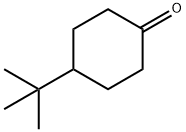A7802012
4-tert-Butylcyclohexanone , 99% , 98-53-3
CAS NO.:98-53-3
Empirical Formula: C10H18O
Molecular Weight: 154.25
MDL number: MFCD00001642
EINECS: 202-678-5
| Pack Size | Price | Stock | Quantity |
| 1g | RMB24.00 | In Stock |
|
| 5G | RMB28.80 | In Stock |
|
| 25G | RMB56.00 | In Stock |
|
| 100G | RMB204.00 | In Stock |
|
| 500G | RMB857.60 | In Stock |
|
| others | Enquire |
Update time: 2022-07-08
PRODUCT Properties
| Melting point: | 47-50 °C (lit.) |
| Boiling point: | 113-116 °C/20 mmHg (lit.) |
| Density | 0.893 |
| vapor pressure | 7.91-14.2Pa at 20-25℃ |
| refractive index | 1.4570 (estimate) |
| Flash point: | 205 °F |
| storage temp. | Sealed in dry,Room Temperature |
| solubility | Chloroform (Slightly), Methanol (Slightly); Almost insoluble in water, soluble in alcohol and oils. |
| form | Crystalline Powder |
| color | White to almost white |
| Odor | Powerful, dry-camphoraceous, slightly minty odor with woody Cedar-Patchouli-like undertones. |
| Odor Type | woody |
| Water Solubility | Soluble in alcohol, ethanol (0.5g/10 mL). Insoluble in water. |
| BRN | 507309 |
| InChIKey | YKFKEYKJGVSEIX-UHFFFAOYSA-N |
| LogP | 2.91 |
| CAS DataBase Reference | 98-53-3(CAS DataBase Reference) |
| NIST Chemistry Reference | Cyclohexanone, 4-(1,1-dimethylethyl)-(98-53-3) |
| EPA Substance Registry System | Cyclohexanone, 4-(1,1-dimethylethyl)- (98-53-3) |
Description and Uses
4-tert-Butylcyclohexanone is used as a perfuming agents and in cosmetic. This material, commercially available for almost two decades, has only temporarily gained some importance as a powerful, “lifting” soap perfume ingredient, or as an in-expensive additive to Patchouli notes for soap and detergent fragrances, etc. It has more power and much less tenacity than Cedarwood and Patchouli, which is only an advantage in certain types of household products, where tenacity is not always very desirable. The title ketone can also give powerful “lift” to certain types of floral fragrance and to most of the herbaceous ones, Lavender, Lavandin, Rosemary, etc.
Safety
| Symbol(GHS) |  GHS07 |
| Signal word | Warning |
| Hazard statements | H302-H412 |
| Precautionary statements | P273-P301+P312+P330 |
| Hazard Codes | Xi |
| Risk Statements | 36/37/38 |
| Safety Statements | 26-36 |
| WGK Germany | 2 |
| RTECS | GW1140000 |
| TSCA | Yes |
| HS Code | 29142990 |
| Toxicity | Both the acute oral LD50 value in rats and the acute dermal LD50 value in rabbits were reported to be 5 g/kg |



